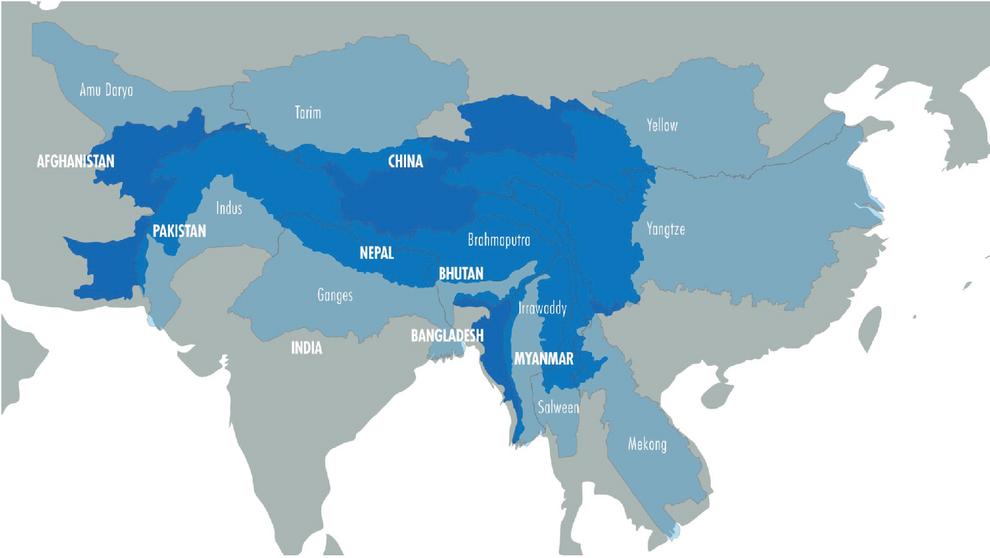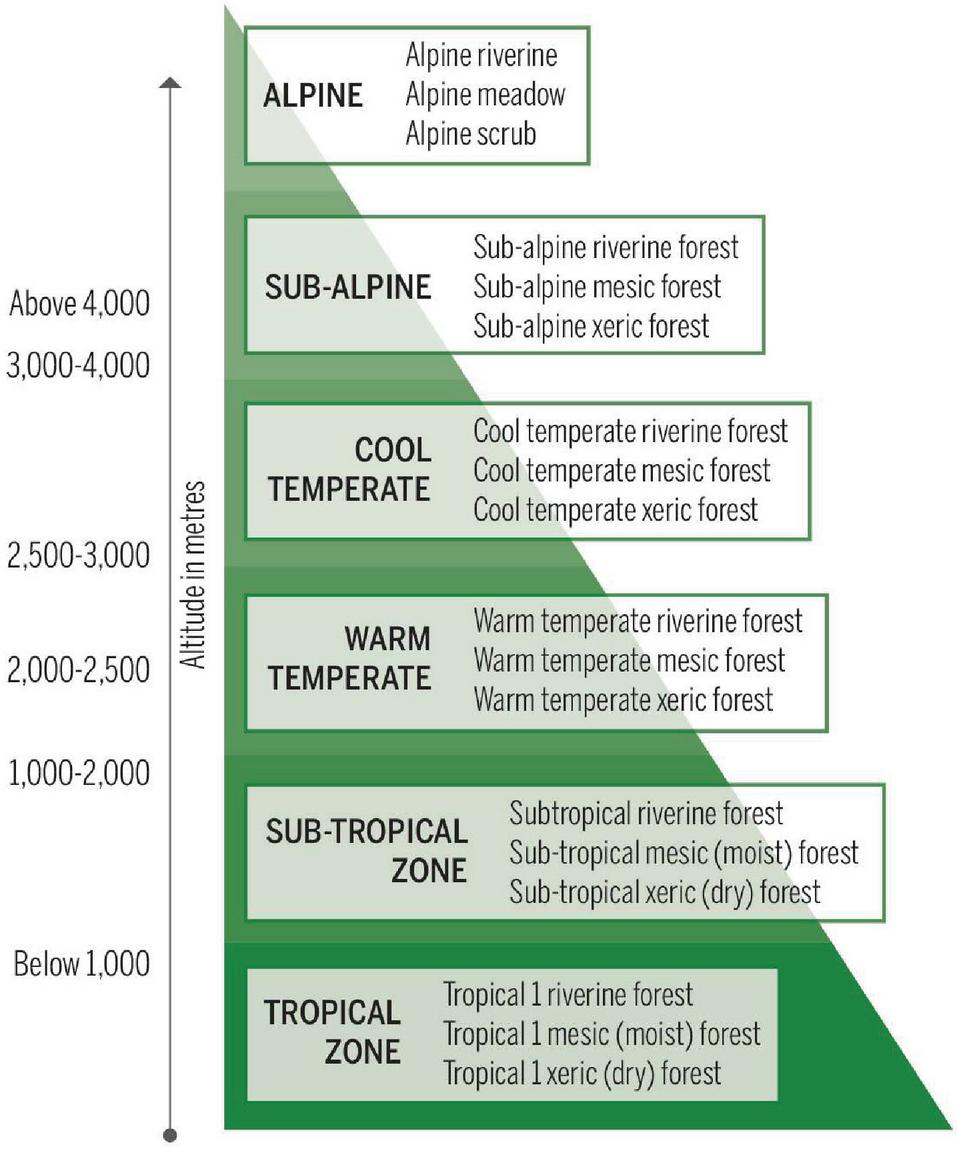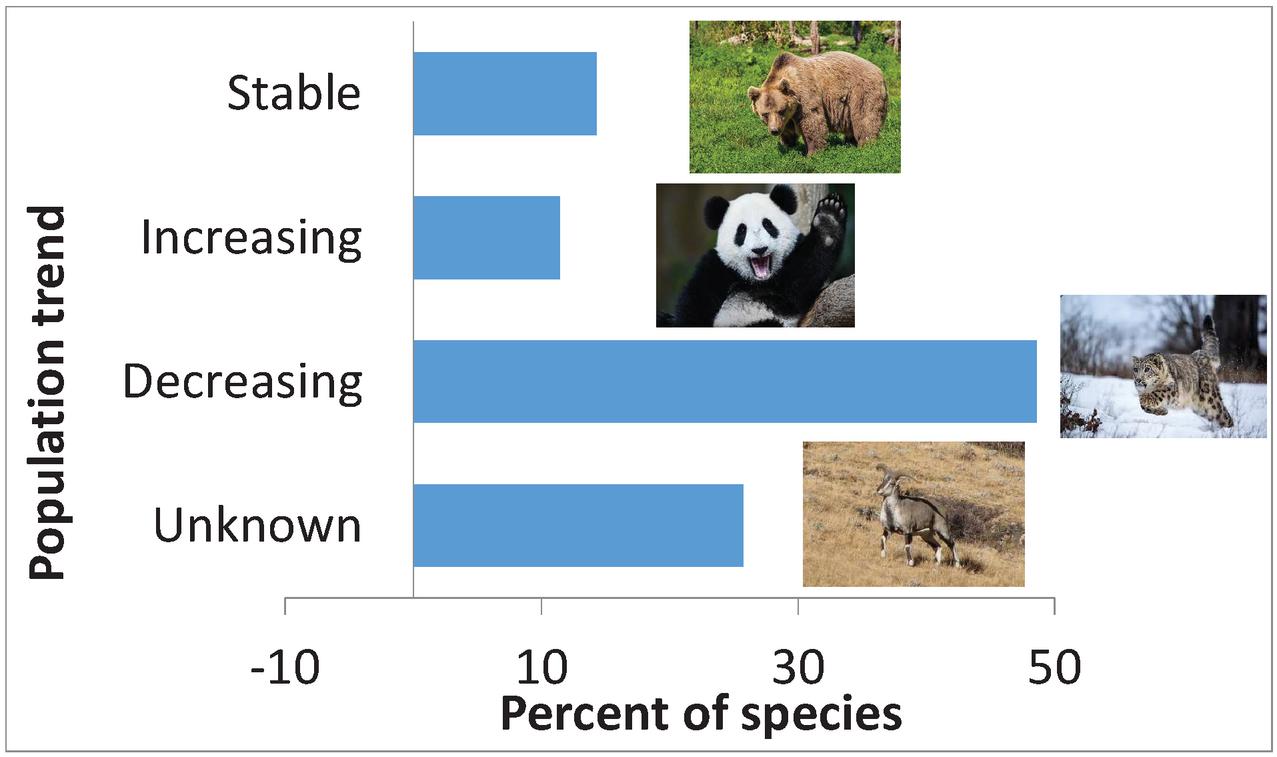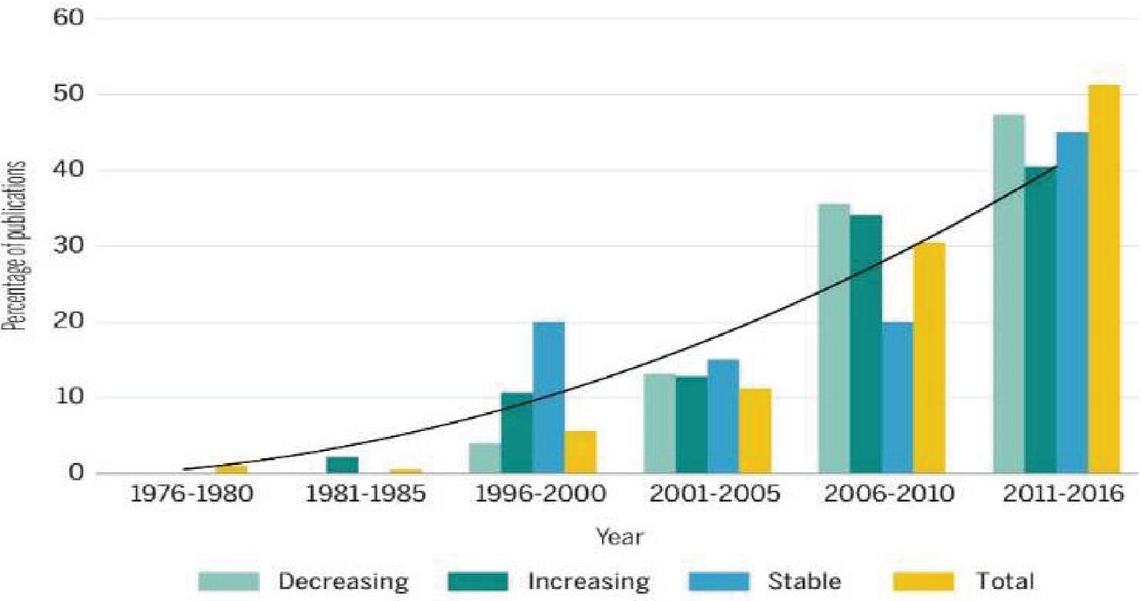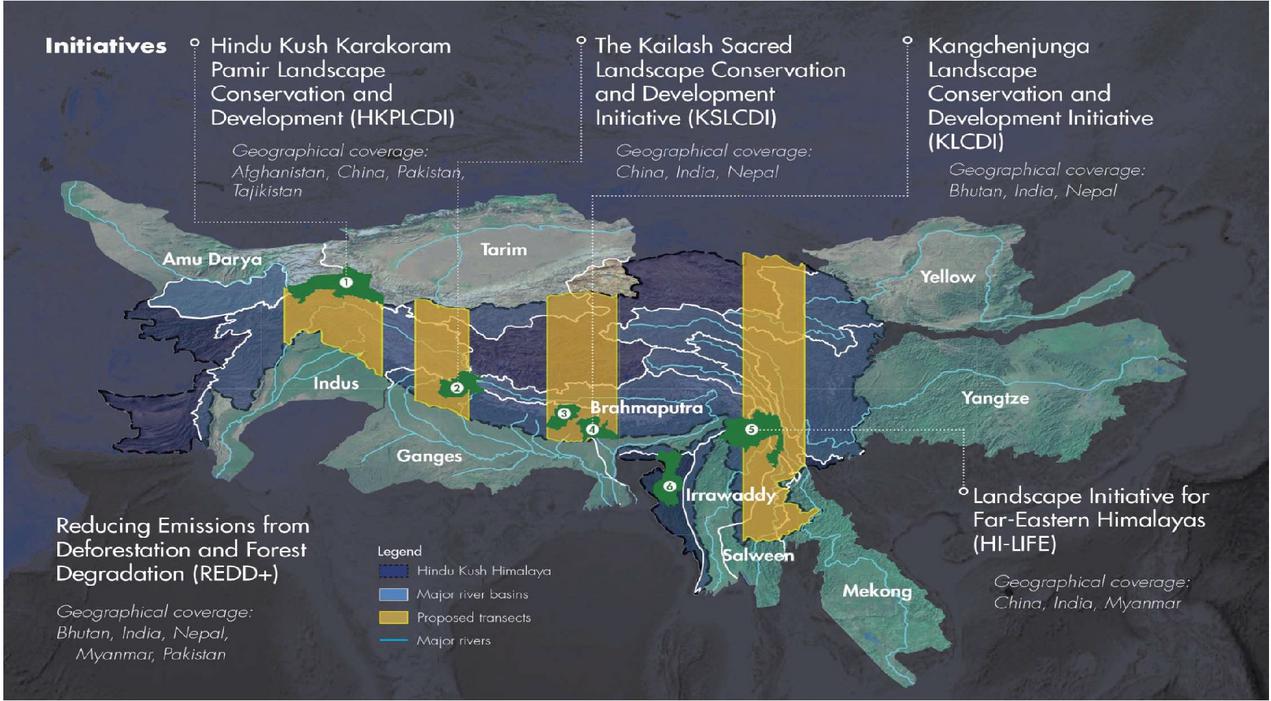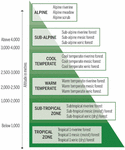Biodiversity Conservation and Ecosystem Services in the Hindu Kush Himalaya
Eklabya Sharma and Nakul Chettri
International Centre for Integrated Mountain Development, Kathmandu, Nepal
E-mail: Nakul.Chettri@icimod.org
*Corresponding Authors
Received 15 November 2020; Accepted 24 January 2021; Publication 26 May 2021
Abstract
With 22% global land surface area, the mountains ecosystem is home to 13% of the total human populations. Evolved as a unique ecosystem, the mountain adds value with diverse ecosystems; tradition and culture as well as ecosystem services for socio-economic development in the mountain areas and beyond. As it caters half of the humanity with its diverse types of ecosystem services, the realization of its significance are still limited in national, regional and global discourses. In the conservation front, there has been a significant progress in the concept and practices from species focussed interventions to habitat and ecosystem/landscape conservation approaches. The Hindu Kush Himalaya (HKH), known as the highest mountain ecosystems in the world is also the water tower for the region often referred as the third pole. This unique ecosystem is an important repository of biological and cultural diversities and source of varied ecosystems services to 240 million people living within and about a one third of global population living downstream. The region has been in spotlight for being part of the 36 ‘Global Biodiversity Hotspot’ as well as climate change hotspot. However, our understanding the dynamics of changing landscapes and climate and its linkage to people, mostly challenged by poverty are limited. International Centre for Integrated Mountain Development (ICIMOD), an inter-governmental regional knowledge and enabling centre, has been instrumental in developing knowledge about the dynamics of these fragile ecosystems and support its regional member countries through science based integrated approaches. Since its inception, ICIMOD has been engaged in developing knowledge and supporting policies for mountain development focusing on socio-economic, ecological and environmental dimensions. In this paper, we present the retrospect of our understanding and learnings in the HKH through transboundary landscape management and regional cooperation mostly focused on conservation of biodiversity and ecosystem services perspectives. The paper reflects on changing paradigm and complex process for strengthening regional cooperation in the HKH.
Keywords: Mountains, Global Biodiversity Hotspot, Landscape approach, Regional Cooperation.
1 Introduction
With 22% coverage of terrestrial land surface and home to 13% global population, the mountains ecosystems are unique (FAO 2015). Due to the extreme variations in biophysical system such as elevation, slope and aspects, the mountains possesses diverse microclimate resulting to variations in vegetation and ecological conditions (Antonelli et al. 2018; Huang et al. 2019). This biophysical diversity adds high biodiversity, often with sharp transitions between the ecosystems or ecotones along with vegetation pattern, soil quality to permafrost in the form of snow and ice (Rahbek et al. 2019). In the recent time, it has also been realized that the climate and land use pattern have also enriched biodiversity in the mountain ecosystems (Peters et al. 2019). Due to its complex and diverse conditions mountain ecosystems are blessed with endemic species, because many species are compartmentalized due to elevations between high and lowland communities that occupy climatic niches spread over wider latitudinal belts (Kornor and Sphen 2019). At present, half of the 36 Global Biodiversity Hotspots are in the mountains making it important for global community (Perrigo et al. 2020). Thus, they are the last stronghold of wilderness areas among the widely transformed habitats and provide a number of very important ecological functions (Hamilton 2002).
The biodiversity and ecosystem services from the mountains contribute to half of the global population for their wellbeing living in the mountains and downstream (Sharma et al. 2019). In addition, the rich biodiversity and intact forests in the mountain helps in other functions such as soil stabilization in the headwaters, control flooding, and provide continuous flows ecosystem services including feeding through springshed into underwater aquifers. Due to such important functions, the mountains are often referred as ‘water towers’, which are the lifeline for maintaining densely populated downstream (Sharma et al. 2019). There are evidences that even the prehistoric civilization including hunters and gatherers preferred mountains due to abundance of plant and animal diversity, water, wild edibles, shelter and conditions favorable for self-defense (Krylovick et al. 2019). However, the fragile mountain ecosystems are facing numerous challenges. The human induced pressure through over exploitation and land use change are leading to habitat degradation, fragmentation, enabling niche for invasive species which are the major drivers of biodiversity loss (Xu et al. 2019). Climate change, which is reported to be higher in rate due to elevation dependent wraming in the mountains is expected to be a major driver in the 21st century, with strong implications on fragile ecosystems of the mountains (Parmesan 2006; Aukema et al. 2017). Therefore, it is imperative to plan for interventions that minimizes further damage on these critically important ecosystem and ensure wellbeing of 85% of dependent local community (Palomo 2017; Xu et al. 2019).
The Hindu Kush Himalaya (HKH), the working area of the International Centre for Integrated Mountain Development (ICIMOD), is one of the most dynamic regions with rich biodiversity (Sharma et al. 2019, Figure 1). Owing to the diversity of ecosystem due to elevation and soil formation, the HKH vegetation are rich in unique flora and fauna with high endemism (Xu et al. 2019). However, HKH is also loosing species with extinction from some of the prominent drivers of change such as land use change, pollution and climate change (Chettri and Sharma 2016). The resources in the HKH are declining due to lack of incentive to the local communities for conserving biodiversity and water resources. The aspiration of economic development is slowly being compromised with the fragile ecosystems leading to loss of biodiversity and increasing the vulnerability. There are evidences that even some protected areas (PAs) are not spared and face human pressures from and communities living inside as well as outside (Gurung et al. 2019). Supported by ten major rivers, the HKH in an important sources for vital ecosystem services such as water for the region and the downstream basins for hydropower, water supply, agriculture, and tourism – supporting economy of the countries within the region and downstream. It is worth noting that during 2009/2010, Bhutan generates 16.3% revenue from hydropower to the nominal gross domestic product (GDP) or 39% in terms of total exports (RMA, 2011). This paper highlights the importance of HKH for biodiversity, ecosystem services and emerging challenges and drivers of change and also share some interventions, opportunities to build social-ecological resilience in the region for sustainable future along with learnings.
Figure 1 The Hindu Kush Himalaya and the river basins.
2 Hindu Kush Himalaya – The Significance
Covering more than 4.3 million km across Afghanistan, Bangladesh, Bhutan, China, India, Myanmar, Nepal, and Pakistan, the HKH is characterized rich biodiversity, cultural diversity along with some of the most complex terrain (Xu et al. 2019). Driven by plate tectonics, the mountains of the HKH have been blessed with altitudinal and soil variation giving rise to diverse micro climates and ecological gradients. The HKH is the youngest and one of the most diverse ecosystems among the global mountain ecosystems. Variations are observed across the elevation resulting to change of vegetation from tropical to alpine in a short distance (see Figure 2). Such variations are manifested by climatic variation, as well as altitudinal, latitudinal, and soil gradients (Sharma et al. 2010). This diverse biophysical habitat sets the stage for a rich biodiversity and species evolution (Xu et al. 2019). The HKH is the source of ten major river systems feeding to productive landscapes with strong upstream downstream linkages (Wester et al. 2019). The region also includes all or part of four global biodiversity hotspots – Himalaya, Indo-Burma, mountains of Southwest China, and mountains of Central Asia (Mittermeier et al. 2011; Chettri et al. 2010) – with high proportion of threatened species and endemism with one of the highest rate of deforestation and habitat degradation (Table 1). Moreover, the region also reported to have more than 60 different ecoregions, out of which 12 are part of the Global 200 ecoregions (Olson and Dinerstein 2002). Interestingly, more than 39% of the HKH is under protected area network with about 35 new species per year being reported from the Eastern Himalaya alone (Chettri et al. 2008; Xu et al. 2019). Recent analysis reported more than 50% of species are under pressure of decreasing population (Xu et al. 2019, Figure 3).
Figure 2 Vegetation zones and dominant forest types found across the HKH (Chettri et al. 2010).
Table 1 Total and endemic (in parenthesis) species in the four biodiversity hotspots
| Mountains of | Mountains of | |||
| Biodiversity | Himalaya | Indo-Burma | Southwest China | Central Asia |
| Plants | 10,000 (3,136) | 13,500 (7,000) | 12,000 (3,500) | 5,500 (1,500) |
| Mammals | 300 (12) | 433 (73) | 237 (5) | 143 (6) |
| Birds | 977 (15) | 1,266 (64) | 611 (2) | 489 (0) |
| Reptiles | 176 (48) | 522 (204) | 92 (15) | 59 (1) |
| Amphibians | 105 (42) | 286 (154) | 90 (8) | 7 (4) |
| Freshwater fish | 269 (33) | 1,262 (553) | 92 (23) | 27 (5) |
| Source: Xu et al. (2019). | ||||
Figure 3 Status of threatened species (Source Xu et al. 2019).
The ecosystem services coming from the HKH is the source of livelihood for 240 million people livinh within the HKH and the benefit are also going to 1.9 billion people living in the river basin (Sharma et al. 2019). These services are the basis of livelihoods in the form food, timber, fibre, medicine and as well as water for drinking and irrigation. There are evidence that the mountain ecosystems also play a role in climate regulation, carbon storage, and the maintenance of aesthetic, cultural, and spiritual values (Sharma et al. 2015; Chaudhary et al. 2017; Xu et al. 2019). The diverse vegetations in the highland ecosystems, forests and agroforestry systems in the mountains helps to stabilize headwaters, prevent flooding, landslide and maintain steady year-round flows of water, vital for the densely populated downstream areas. As a result, mountains have often been referred to as ‘water towers’ (Molden et al. 2014; Mukherji et al. 2015). However, though there is an increasing interest on ecosystem services research in the recent decades, the both the quality and quantity of ecosystem services have been reported decreasing in most of the ecosystems (Xu et al. 2019; Figure 4).
Figure 4 Trend in number of publications on ecosystem services in the HKH, and number of these that predict/suggest/report a decline, increase, or stable state of ecosystem services (source Xu et al. 2019).
3 Emerging Challenges and Drivers of Change
As the global change is happening, the HKH has also witnessing various changes due to direct and indirect drivers of changes. Some of the prominent drivers reported are habitat degradation as a result of land use change, pollution, intrusion of invasive species and more importantly the climate change (Chettri and Sharma 2016, Wang et al. 2019). Over exploitation leading to forest fragmentation has been identified as one of major drivers in both western (Uddin et al. 2015; Xu et al. 2019) and eastern Himalayas (Ravindranath et al. 2011). Sensitive and fragile ecosystems such as high altitude wetlands and rangelands are reported to be more vulnerable to the combined effects climate change, land use change, over exploitations etc. (Chettri et al. 2010; Chaudhary et al. 2017). As a result, the fragile ecosystem is losing soil due to increased erosions and frequency of floods (Cánovas et al. 2017).
The recent analysis covering the HKH revealed that change are happening and some are prominent as a results of climate change (Sharma et al. 2019) and unplanned development (Xu et al. 2019). Interestingly, both negative and positive impacts of the various drivers are revealed such as change in wildlife population, plant phenology, and ecosystem productivity across the region (Xu et al. 2019). In the recent time, there has been more frequent natural disasters – both in terms of frequency and damage. It is also interpreted that the traditional resources management systems are being ignored resulting to decreased resilience (Elalem and Pal 2015). As a result, the fragile ecosystems of the HKH, which are important natural assets contributing to the well-being of people as well as biodiversity in the HKH and beyond, are being impacted (Xu et al. 2019, Kandel et al. 2020). Such impacts have the cascading effects supply of ecosystem services, which on the other hand increases the demand for these resources leading to more pressure on the ecosystems and human society (Sharma et al. 2015; Chaudhary et al. 2016).
4 Integrated Landscape Approach
In the recent years, biodiversity and ecosystem services in the HKH is rapidly changing as a result of both anthropogenic and natural drivers. However, many of such drivers as well as the consequences are transboundary in nature and, so far, very limited efforts are in practice for regional cooperation for collective actions among the member countries (Sharma et al. 2019). Conservation and development have been a dilemma in the HKH as elsewhere due to fragile and inaccessible areas and aspiration for economic growth. Though there are interdependency on many sectors such as tourism, agricultural, water and clean energy, efforts to sustain these services, including managements of common and contiguous ecosystems such as forests, wetlands, and rangelands is becoming challenging (Rasul 2014). As the populations are increasing, the increasing demand of food, water and energy is becoming a competing challenge to minimize trade-offs and maximize synergies.The complex social-ecological system need holistic approach. An integrated landscape concept considering equality and social inclusion at scale is emerging as a promising approach in reforming governance policies and institutional and legal frameworks that promote conservation and sustainable use of biodiversity and ecosystem services. In the past, the conservation and development dilemma, lack of synergy among the sectors and system thinking were not considered for the complex ecosystem such as the HKH. One of the emerging option such as mountain tourism is one example where biodiversity conservation, cultural preservation, socioeconomic development, and environmental aspects could be better linked and coordinated (Chettri et al. 2020).
It is evident that the socio-ecological systems could be addressed when system thinking at at landscape level is considered (Sayer 2009). Our own learning from the past decades suggest that transdisciplinarity and participatory process in the landscape approach has the potential to maximize synergy and secure integrated actions by multiple stakeholders (Xu et al. 2019). In many instances, the landscape approach, including transdisciplinarity, have shown varying degrees of success even in the HKH (Chettri and Sharma 2016; Gurung et al. 2019). Even at the global level, such practices are recommended as principles of intergovernmental process dealing with biodiversity conservation and climate change mitigation and adaptation (Sayer et al. 2013). Such practices could be instrumental when looked at different scales considering the linkages for raising the adaptive capacity of people and resilience of ecosystems. Some recommendations even suggests to look at the river basin level for better synergy and coordination (Rasul 2014; Chettri and Sharma 2016).
Although, documentation on good practices in community-based conservation and development initiatives are evolving, the challenges still exist in terms of representation on research, science based decision making, information and knowledge sharing and regional cooperation (Gurung et al. 2019). Fortunately, there are some positive change being observed in the HKH. The changing paradigm from ‘people exclusionary’ and ‘species-focused’ to ‘people-centred community-based’ approache in biodiversity conservation is observed in the HKH on the basis of the United Nations Conference on Environment and Development (UNCED) in 1992, which placed a premium on people’s participation and promotion of this conceptual shift in both natural resources management and biodiversity conservation (UN 1992). In response, community based participatory approaches at landscape level evolved as the accepted means in various sectors in the HKH (Sharma et al. 2010). The coventional approach of biodiversity conservation focussing on species (Yonzon 1989; Wikramanayake et al. 1998), evolved to landscape level conservation considering transboundary perspective, with the understanding that ‘conservation and management of biodiversity are impossible without people’s participation’ (Gurung et al. 2019). Starting from 1980s, de-centralization and devolution of authority to local community for biodiversity conservation have been evident in governments’ efforts across the HKH (Sharma et al. 2010). As a result, a strong realization of people’s participation considering the utility value of resources, is critical for biodiversity management to make it more effective (see Gurung and Seeland 2008). Later, during the late 1990s, a new dimension with the concept of linking the existing protected areas with biological corridors evolved in the HKH (Sherpa and Norbu 1999). This approach, with the twin objective offacilitating migration through corridors in the habitat contiguity and species refugia in response to environmental pressures such as climate change became popular. In early 2000, the concept of landscape approaches evolved in the region, generally adopting the ecosystem approach advocated by the Convention on Biological Diversity (CBD) (see Sharma et al. 2010; Gurung et al. 2019). These transformative understanding and realization addressed both ex-situ and in-situ approaches. In addition, the good practices from traditional ecological knowledge, belief, and culture also contributed substantially in addressing the conservation goal.
Over the years, ICIMOD has been a global player in advocating mountains perspectives and agendas since its existence. Being an active mountain partnership member and observers for numerous multilateral environmental agreements such as convention on biological diversity (CBD) and the United Nations Framework Convention on Climate Change (UNFCCC), ICIMOD has been playing an important bridging role for customizing global agendas to local and regional levels and vice versa. Catering to its member countries based on contemporary challenges and opportunities, ICIMOD advanced through different phases and priorities (Molden and Sharma 2013). At present, ICIMOD is in its fourth medium term action plan (2018–2022) with six integrated programmes supported by four thematic areas (ICIMOD 2017). Among the six programmes, transboundary landscapes is an important integrated and multi-disciplinary regional programme that focusses on systematic planning of mountain ecosystems and to develop nature based solutions for sustainable and equitable development (see Molden et al. 2017).The programme is now working in four landscapes (Hindu Kush Karakoram Karakoram Pamir, Kailash, Kangchenjunga, and Far Eastern Himalayas (Molden et al. 2017; Figure 5). The exsiting four operational programmes have a long term vision of 20 years and the strategic process of conservation and development interventions have been developed. As mandated ICIMOD is working across HKH countries to help attain common goals related to sustainable development, by bringing together different groups within programmatic transboundary approaches covering scales from households, springshed, landscapes to river basins.
Figure 5 Map showing ‘Trans-Himalayan Transacts’ and ‘Transboundary Landscapes’ in the HKH.
To sustain the ecosystem services and conserve rich biodiversity, ICIMOD supports regional and transboundary cooperation to meet challenges of climate change, disaster risks, and sustainable development in the HKH through integrating transboundary landscape and river basin programmatic focus. Actions to sustain the HKH have the potential to directly improve the lives of more than one third of the world’s population. However, facilitating cooperation and policy coherence among the countries sharing HKH resources is a persistent challenge in a region with highly variable priorities regarding development. ICIMOD’s interventions focus on knowledge development, human resources development, technology transfer, policy outreach, and innovations through demonstrations. In the prevailing condition of COVID 19, initiatives have been taken to strategize interventions considering resilient recovery through six major HKH Call to Action with special focus on ecosystem and biodiversity as one of the priority actions (ICIMOD 2020a,b).
Conclusion
With rich biodiversity and being source of diverse ecosystem services, the HKH is important for the people of the HKH and downstream. Known for being all or parts of four global biodiversity hotspots and water tower of the region, it contributed to the wellbeing of the 240 million people of the region, 1.9 billion people in the downstream areas. However, the prevailing drivers of changes, including climate change, land use change, pollution, invasive species and over-exploitation of fragile ecosystems are adding challenges for maintaining and sustaining this global asset. In addition, local, regional and global market forces; and the socio-political environment are also changing posing pressure on the fragile ecosystem. Unfortunately, our sectorial interventions and understanding and lack of integrated approach is making the conservation and management of resources challenging. Our past approaches were not adequate due to lack of interdisciplinary system thinking for generating knowledge, governance systems. Furthermore, the recent resources use patterns by the growing urban population have further impacted biodiversity and the functions and flow of services from ecosystems.
However, these prevailing threats and their drivers have provide the stakeholders of the HKH with new avenues for regional co-operation for information and knowledge sharing, exchange of good practice, learnings and experience to develop robust strategies for managing the socio-ecological systems that are dependent on the sustained flow of ecosystem services. The recent development in resources governance through changing perspectives such as species to a landscape and ecosystem approach, joining hand for regional cooperation through HKH Call to action are promising. Yet the road to achieve the goal of making the HKH resources managed and sustained for future generations is still long way to go. Innovative strategies and cooperation are needed to build resilience in the ecosystems and the communities to withstand the threats brought about by large local, regional, and global changes.
Our own learning revealed that the challenges in the HKH are not limited to national boundaries as the impact of climatic change is faced by the entire region. Therefore, there is not option left than strengthening regional cooperation at the government, civil society, private sector, and community levels. Integrated approach considering social-ecological system thinking in policies and their implementation are required across different sectors to address some of the challenges mentioned above. In the science, policy and practice linkage, decision makers at all levels need to work with information and knowledge providers and seek inputs that is holistic, interdisciplinary, and exemplified with best practices from elsewhere. Further, our good practices need to be scale-out and scale up and enhance knowledge and information about the heritage values that biodiversity and ecosystem services provide for informed decision making.
Our learning also brings some lessons such as working on the complex social-ecological system need interdisciplinary approach with engagement of all stakeholders including the private sector. As the HKH region is a global asset, it is equally important for global community to come forward and support the HKH countries for their struggle for balancing conservation and development. In nutshell, the HKH region is an global asset and seeking holistic approach for balancing biodiversity conservation, sustaining ecosystem services and fulfilling aspiration of people for economic development for which the HKH countries, donors, civil society and the private sector need to join hands to ensure the sustainability of the assets while pursuing the larger goals of poverty alleviation, economic development, and overall human wellbeing.
Acknowledgements
The authors are thankful to the Director-General of ICIMOD for his encouragement and support. This study was partially supported by the core funds of ICIMOD, contributed to by the governments of Afghanistan, Australia, Austria, Bangladesh, Bhutan, China, India, Myanmar, Nepal, Norway, Pakistan, Switzerland, and the United Kingdom. The views and interpretations in this publication are those of the authors. They are not necessarily attributable to ICIMOD and do not imply the expression of any opinion by ICIMOD concerning the legal status of any country, territory, city or area of its authorities, or concerning the delimitation of its frontiers or boundaries, or the endorsement of any product.
References
Antonelli, A., Kissling, W. D., Flantua, S. G., Bermúdez, M. A., Mulch, A., Muellner-Riehl, A. N., …& Fritz, S. A. (2018). Geological and climatic influences on mountain biodiversity. Nature Geoscience, 11(10), 718–725.
Aukema J.E., Pricope N.G., Husak G.J. et al. (2017). Biodiversity areas under threat: overlap of climate change and population pressures on the world’s biodiversity priorities. PLoS One 12(1): e0170615. doi:10.1371/journal. pone.0170615
Cánovas J.B., Trappmann D., Shekhar M. et al. (2017). Regional flood-frequency reconstruction for Kullu district, Western Indian Himalayas. Journal of Hydrology 546: 140–149.
Chaudhary, S., Chettri N., Uddin, K. et al. (2016) Implications of land cover change on ecosystem services and people’s dependency. A case study from the KoshiTappu Wildlife Reserve, Nepal. Ecological Complexity. 28: 200–211.
Chaudhary, S., Tshering, D., Phuntsho, T., Uddin, K., Shakya, B., & Chettri, N. (2017) Impact of land cover change on a mountain ecosystem and its services: case study from the Phobjikha valley, Bhutan. Ecosyst Health and Sustainability. 3: 1–12.
Chettri, N., & Sharma, E. (2016). Reconciling the mountain biodiversity conservation and human wellbeing: Drivers of biodiversity loss and new approaches in the Hindu-Kush Himalayas. Proceeding of Indian National Science Academy. 82: 53–73.
Chettri, N., Sharma, E., Shakya, B., Thapa, R., Bajracharya, B., Uddin, K., Oli, K., & Choudhury, D. (2010). Biodiversity in the Eastern Himalayas: Status, trends and vulnerability to climate change; Climate change impact and vulnerability in the Eastern Himalayas – Technical report 2. Kathmandu: ICIMOD.
Chettri, N., Shakya, B., Thapa, R., & Sharma, E. (2008). Status of a protected area system in the Hindu Kush-Himalayas: An analysis of PA coverage. International Journal on Biodiversity Sceince and Management. 4: 164–178.
Chettri, N., Lama, A.K., Gaira, K.S., Pandey, A., Dema, K., Uprety, Y., & Sharma, E. (2020). Transboundary cooperation for mountain tourism in the Kangchenjunga Landscape. In Wymann von Dach, S. & Ruiz Peyré, F., (eds.). Vibrant mountain communities. Regional development in mountains: Realizing potentials, tackling disparities. Bern, Switzerland, Centre for Development and Environment (CDE), University of Bern, with Bern Open Publishing (BOP). pp. 36–38.
Elalem, S., & Pal, I. (2015). Mapping the vulnerability hotspots over Hindu-Kush Himalaya region to flooding disasters.Weather and Climate Extremes, 8: 46–58.
FAO (2015). Mapping the vulnerability of mountain peoples to food insecurity. Rome, Italy: Food and Agriculture Organization of the United Nations.
Gurung, D. B., & Seeland, K. (2008). Ecotourism in Bhutan: Extending its benefits to rural communities. Annals of Tourism Research, 35(2): 489–508.
Gurung, J., Chettri, N., Sharma, E., Ning, W., Chaudhary, R. P., Badola, H. K., Wangchuk, S., Uprety, Y., Gaira, K.S., Bidha, N., Phuntsho, K., Uddin, K., & Shah, G.M. (2019). Evolution of a transboundary landscape approach in the Hindu Kush Himalaya: Key learnings from the Kangchenjunga Landscape. Global Ecology Conservation. 17: e00599.
Hamilton, L.S. (2002). Why mountain matters? World Conservation: The IUCN Bulletin 1/2002.
Huang, S., Meijers, M. J., Eyres, A., Mulch, A., & Fritz, S. A. (2019). Unravelling the history of biodiversity in mountain ranges through integrating geology and biogeography. Journal of Biogeography, 46(8), 1777–1791.
ICIMOD (2017). Medium Term Action Plan 2018-2022. ICIMOD, Kathmandu, Nepal.
ICIMOD (2020a). The HKH Call to Action to sustain mountain environments and improve livelihoods in the Hindu Kush Himalaya. ICIMOD, Kathmandu, Nepal.
ICIMOD (2020). COVID-19 impact and policy responses in the Hindu Kush Himalaya. International Centre for Integrated Mountain Development. ICIMOD, Kathmandu, Nepal.
Kandel, P., Chettri, N., Chaudhary, S., & Uddin, K. (2020). Ecosystem services research trends in the water tower of Asia: A bibliometric analysis from the Hindu Kush Himalaya. Ecological Indicators. https://doi.org/10.1016/j.ecolind.2020.107152.
Korner, C., & Spehn, E. M. (Eds.). (2019). Mountain biodiversity: a global assessment (Vol. 7). Routledge.
Krylovich, O., Vasyukov, D., Khasanov, B., Hatfield, V., West, D., & Savinetsky, A. (2019). Hunter-gatherers subsistence and impact on fauna in the Islands of Four Mountains, Eastern Aleutians, Alaska, over 3000 yr. Quaternary Research, 91(3): 983–1002.
Mittermeier, R. A., Turner, W. R., Larsen, F. W., Brooks, T. M., & Gascon, C. (2011). Global biodiversity conservation: the critical role of hotspots. In Biodiversity hotspots. Springer, Berlin, Heidelberg. pp. 3–22.
Molden, D., & Sharma, E. (2013). ICIMOD’s strategy for delivering high-quality research and achieving impact for sustainable mountain development. Mt Res Dev. 33(2): 179–183.
Molden, D., Sharma, E., Shrestha, A.B., Chettri, N., & Shrestha, N. (2017). Advancing regional and transboundary cooperation in the conflict-prone Hindu Kush Himalaya. Mountain Research and Development. 37(4): 503–508.
Molden, D. J., Vaidya, R. A., Shrestha, A. B., Rasul, G., & Shrestha, M. S. (2014). Water infrastructure for the Hindu Kush Himalayas. Int J Water Res Dev. 30(1): 60–77.
Mukherji, M., Molden, D., Nepal, S., Rasul, G., & Wagnon, P. (2015). Himalayan waters at the crossroads: issues and challenges, International Journal on Water Resources Development. 31(2): 151–160.
Wang, Y., Wu, N., Kunze, C., Long, R., & Perlik, M. (2019). Drivers of change to mountain sustainability in the Hindu Kush Himalaya. In The Hindu Kush Himalaya Assessment (pp. 17–56). Springer, Cham.
Olson, D. M., & Dinerstein, E. (2002). The Global 200: Priority ecoregions for global conservation. Annals of Missouri Botanical Garden. 199–224.
Parmesan, C. (2006). Ecological and evolutionary responses to recent climate change. Annual Review of Ecology Evolution and Systematics. 37: 637–669.
Palomo I. (2017). Climate change impacts on ecosystem services in high mountain areas: A literature review. Mt Res Dev 37(2): 179–187.
Perrigo, A., Hoorn, C., & Antonelli, A. (2020). Why mountains matter for biodiversity. Journal of Biogeography, 47(2): 315–325.
Peters, M. K., Hemp, A., Appelhans, T., Becker, J. N., Behler, C., Classen, A., …& Gebert, F. (2019). Climate-land-use interactions shape tropical mountain biodiversity and ecosystem functions. Nature, 568(7750): 88–92.
Rahbek, C., Borregaard, M. K., Antonelli, A., Colwell, R. K., Holt, B. G., Nogues-Bravo, D., …& Fjeldså, J. (2019). Building mountain biodiversity: Geological and evolutionary processes. Science, 365(6458), 1114–1119.
Rasul, G. (2014). Food, water, and energy security in South Asia: a nexus perspective from the Hindu Kush Himalayan region? Environmental Science & Policy, 39, 35–48.
Ravindranath N H, Chaturvedi R K, Joshi N. V. et al. (2011) Implications of climate change on mitigation potential estimates for forest sector in India. Mitigation and Adaptation Strategies for Global Change. 16(2): 211–227.
RMA (2011) Annual Report 2009/10. Royal monetary authority of Bhutan. Royal Government of Bhutan, Thimphu.
Sayer, J., Sunderland, T., Ghazoul, J., Pfund, J. L., Sheil, D., Meijaard, E., …& van Oosten, C. (2013). Ten principles for a landscape approach to reconciling agriculture, conservation, and other competing land uses. Proceedings of the National Academy of Sciences, 110(21): 8349–8356.
Sharma, E., Chettri, N., & Oli, K.P. (2010) Mountain biodiversity conservation and management: a paradigm shift in policies and practices in the Hindu Kush-Himalayas. Ecological Research. 25: 905–923.
Sharma, B., Rasul, G., & Chettri, N. (2015). The economic value of wetland ecosystem services: evidence from the KoshiTappu Wildlife Reserve, Nepal. Ecosystem Services, 12: 84–93.
Sharma, E., Molden, D., Rahman, A., Khatiwada, Y. R., Zhang, L., Singh, S. P., …Wester, P. (2019) Introduction to the Hindu Kush Himalaya assessment. In: Wester P., Mishra A., Mukherji A., Shrestha A. (eds) The Hindu Kush Himalaya Assessment. Springer, Cham. pp. 1–16.
Sherpa, M. & Norbu, U.P.(1999). Linking protected areas for ecosystem conservation: a case study from Bhutan. Parks 9: 35–45.
Uddin, K., Chaudhary, S., Chettri, N., Kotru, R., Murthy, M., Chaudhary, R. P., Ning, W., Shrestha, S, M, & Gautam, S. K. (2015). The changing land cover and fragmenting forest on the Roof of the World: A case study in Nepal’s Kailash Sacred Landscape. Landsc Urban Plan 141: 1–10.
UN (1992). Report of the United Nations Conference on Environment and Development. Rio de Janeiro 3–14 June 1992. A/CONF.151/26 (Vol. 1).
Wester, P., Mishra, A., Mukherji, A., Shrestha, A. B. (eds) (2019) The Hindu Kush Himalaya Assessment—Mountains, Climate Change, Sustainability and People, Springer Nature Switzerland AG, Cham.
Wikramanayake, E. D., Dinerstein, E., Robinson, J. G., Karanth, U., Rabinowitz, A., Olson, D., …Bolze, D. (1998). An ecology-based method for defining priorities for large mammal conservation: the tiger as case study. Conservation Biology. 12(4): 865–878.
Xu, J., Badola, R., Chettri, N., Chaudhary, R.P., Zomer, R., Pokhrel, B., Sunita, P., Rebecca, P., & Hussain, S.A. (2019). Sustaining Biodiversity and Ecosystem Services in the Hindu Kush Himalaya. In Wester, P.; Mishra, A.; Mukherji, A.; Shrestha, A.B. (Eds.) The Hindu Kush Himalaya Assessment; Springer: Berlin/Heidelberg, Germany, 2019. pp. 127–165.
Yonzon, P. B. (1989). Ecology and conservation of the red panda in the Nepal-Himalayas. Doctoral dissertation, University of Maine.
Biographies

Eklabya Sharma is Vice Chancellor at TERI University of Advance Studies since April 2021. Before joining the University, Dr Sharma was the Deputy Director General of International Centre for Integrated Mountain Development (ICIMOD), an intergovernmental regional knowledge centre based in Kathmandu. Dr Sharma has over 35 years of experience in developing, managing, and implementing programmes on sustainable mountain development in the Hindu Kush Himalaya. His major contributions are in mountain ecosystem studies and ecosystem management, biodiversity conservation, climate change impact assessments, and adaptation and resilience. PhD in Botany, Dr Sharma is the recipient of many prestigious national and international awards including the Eminent Scientist Award from the Government of India and Excellence Award from the Government of Sikkim. He has authored more than 200 publications in eminent international journals.

Nakul Chettri is the Regional Programme Manager for Transboundary Landscapes at ICIMOD. He oversees the flagship transboundary landscape programme by providing strategic direction and management to four transboundary landscapes and REDD initiatives across the Hindu Kush Himalaya. With designated expertise as Sr. Biodiversity Specialists, Dr Chettri has more than 20 years of experience in biodiversity conservation, landscape management, ecosystem services, climate change impact assessment, biodiversity informatics, and upscaling and promotion of transboundary landscapes. With PhD in Zoology from University of North Bengal, India, Dr Chettri has been assigned for major biodiversity portfolio of ICIMOD including as focal person for Convention on Biological Diversity, Intergovernmental Science-Policy Platform on Biodiversity and Ecosystem Services among others and contributed in number of global assessment reports including the Global Assessment of IPBES. Before joining ICIMOD, Dr Chettri served as a Fellow at the Ashoka Trust for Research in Ecology and the Environment in its Eastern Himalayan Programme. He has so far published 60 peer review journal articles in international journals, 52 books, 24 book chapters and more than 25 popular articles. Dr Chettri has PhD and MSc in Zoology from North Bengal University, India.
Journal of Graphic Era University, Vol. 9_1, 1–18.
doi: 10.13052/jgeu0975-1416.911
© 2021 River Publishers
